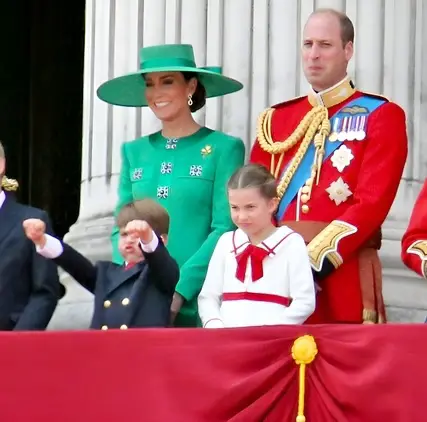The British royal family is steeped in centuries of history, pomp, and circumstance. But behind the glittering tiaras and regal waves lies a world of peculiar practices that would make even the most ardent monarchist scratch their head. From bizarre dining rituals to surprising travel restrictions, these royal traditions are as unconventional as they are fascinating. Let’s dive into the wonderfully weird world of the British monarchy and explore nine of their most bizarre traditions that will leave you both amused and bewildered.
1. The Royal Christmas Weigh-In
Imagine stepping on a scale before and after your Christmas dinner, with your entire family watching. Now imagine doing that in front of the King of England. This peculiar tradition dates back to the reign of Edward VII and continues to this day at the royal family’s Sandringham estate. Guests are weighed upon arrival and again before departure, ostensibly to ensure they’ve been well-fed during their stay.
While it might seem like a festive way to celebrate holiday indulgence, this custom has raised eyebrows and caused discomfort among some royal guests. Princess Diana, known for her struggles with eating disorders, reportedly found this tradition particularly distressing. Despite its controversial nature, the royal family continues to uphold this centuries-old practice, proving that even the most powerful family in Britain isn’t immune to awkward holiday traditions.
2. The Monopoly Ban
Board games are a staple of family gatherings worldwide, but don’t expect to see the royals battling it out over Park Lane and Mayfair. The game of Monopoly is strictly forbidden within the royal household. This surprising ban was reportedly implemented by none other than the Queen herself, who found the game too “vicious” for her liking.
While it’s tempting to imagine Her Majesty flipping the board after landing on a hotel-laden Piccadilly, the reality is likely more nuanced. The competitive nature of Monopoly, with its focus on acquiring wealth and property, might be seen as unbefitting of royal decorum. Or perhaps the royals simply prefer a game of croquet on the palace lawn. Whatever the reason, this ban adds a touch of whimsy to the otherwise formal image of the royal family.
3. The Royal Bedtime Rule
We’ve all experienced that moment at a party when we’re ready to call it a night, but feel obliged to stay until the host retires. Now, imagine that party lasting your entire life. In a tradition that seems straight out of a fairy tale, no one in the royal family is allowed to go to bed before the monarch. This means that whether you’re a young prince with an early tennis lesson or a duchess battling jet lag, you’re expected to keep your eyes open until the King or Queen decides it’s bedtime.
This peculiar custom has led to some amusing situations over the years. Tales of younger royals desperately trying to stay awake during late-night gatherings are not uncommon. It’s said that some have even resorted to sneaking quick naps in secluded corners of the palace. While it might seem like an antiquated rule, it’s a reminder of the deeply ingrained hierarchy within the royal family, where even sleep is governed by tradition.
4. The Royal Shellfish Ban
While the rest of us might enjoy a plate of oysters or a luxurious lobster dinner, the royal family must abstain from such delicacies. Shellfish is strictly off the menu for the British monarchy, a rule that extends to all royal tours and official engagements. This ban isn’t rooted in some ancient superstition or religious observance, but rather in a very practical concern: food poisoning.
The royal family’s busy schedule and public duties mean that they can’t afford to risk falling ill from a bad batch of clams. This rule also extends to rare or undercooked meats, making the royal diet somewhat less adventurous than one might expect. However, it’s worth noting that some younger royals have been known to bend this rule on occasion, perhaps finding the allure of a good prawn cocktail too hard to resist. For those looking to dine like royalty, you might want to consider this seafood cookbook for some shellfish-free inspiration.
5. The Royal Swan Upping
In a tradition that sounds like it was dreamed up by Lewis Carroll, the British monarch participates in an annual swan census along the River Thames. Known as the Swan Upping, this peculiar event dates back to the 12th century when the Crown claimed ownership of all mute swans in England. Every July, a team of swan uppers, led by the Queen’s Swan Marker, sets out to count, measure, and check the health of the swans on the Thames.
The Swan Upping is a spectacle to behold, with the swan uppers dressed in traditional scarlet uniforms, rowing up the river in skiffs. When they encounter a family of swans, they cry “All up!” and the birds are caught, weighed, measured, and ringed before being released back into the water. While the practice originally served to ensure a steady supply of swan meat for royal banquets, it now serves a conservation purpose. This bizarre tradition is a testament to the monarchy’s enduring connection to Britain’s wildlife and waterways.
6. The Royal Hostage Tradition
In a tradition that sounds more like a plot from a political thriller than a royal custom, the monarch takes a “hostage” from Parliament every time they visit. Before the King or Queen enters the Houses of Parliament, a Member of Parliament is ceremonially taken to Buckingham Palace and held there until the monarch safely returns. This bizarre practice dates back to the historical tensions between the Crown and Parliament, particularly the execution of King Charles I in 1649.
While it might sound alarming, the modern-day “hostage” is in no real danger. They’re typically treated to tea and biscuits at the palace while awaiting the monarch’s return. The MP chosen for this role often sees it as an honor rather than a burden. This tradition serves as a quirky reminder of the delicate balance of power between the monarchy and the government, preserved in a ritual that’s more symbolic than sinister.
7. The Royal Black Wardrobe Rule
While most of us associate the color black with elegance and sophistication, for the British royal family, it’s a hue reserved for mourning. Members of the royal family are forbidden from wearing black clothing on normal days, a rule that extends to all public appearances and official engagements. This tradition stems from the Victorian era when black was strictly associated with grief and bereavement.
However, this rule comes with a curious caveat. Despite the ban on wearing black, all royals are required to pack a black outfit whenever they travel. This precaution ensures that they’re prepared to dress appropriately in case of a sudden tragedy or death in the family. It’s a somber reminder of the public nature of royal grief and the constant readiness required of those in the royal spotlight. For those looking to emulate royal style while adhering to this rule, consider this colorful formal wear for your next special occasion.
8. The Royal Handshake Protocol
When meeting a member of the royal family, you might be tempted to extend your hand for a friendly shake. However, you’d be committing a royal faux pas. In royal protocol, it’s the monarch who decides whom they wish to touch. This means that during official events and meetings, guests must wait for the royal to initiate any physical contact, including handshakes.
This rule extends beyond just handshakes. Hugs, kisses on the cheek, and even a friendly pat on the back are all off-limits unless initiated by the royal in question. While it might seem standoffish to some, this tradition serves to maintain the formal nature of royal interactions and preserve the monarch’s authority. It’s also a practical measure, given the number of people royals meet on a daily basis. So, if you ever find yourself in the presence of royalty, remember: hands to yourself unless invited otherwise!
9. The Royal Bee-Whispering Tradition
In a tradition that sounds like it was plucked from a fairy tale, the royal family practices the curious custom of “telling the bees”. Whenever there’s a significant event in the royal family – be it a birth, death, or marriage – someone must inform the royal beehives. This involves draping the hives with black cloth in the event of a death, or decorating them with colorful ribbons for a wedding.
The person tasked with this duty must gently knock on each hive, whisper the news to the bees, and sometimes even leave them a piece of wedding cake or funeral biscuit. This peculiar practice stems from an old English folklore belief that failing to keep the bees informed of important family events would result in the bees leaving their hives or ceasing to produce honey. While it might seem eccentric, this tradition reflects the royal family’s connection to nature and their respect for ancient customs, no matter how bizarre they may seem to modern eyes.
From weighing Christmas guests to whispering to bees, these bizarre traditions offer a fascinating glimpse into the peculiar world of the British monarchy. They serve as a reminder that even in an institution as formal and traditional as the royal family, there’s room for eccentricity and whimsy. These customs, however strange they may seem, are an integral part of the rich tapestry of British royal history, connecting the modern monarchy to centuries of tradition. So the next time you see a royal waving from a balcony or attending a state dinner, remember: behind that polished exterior lies a world of wonderfully weird traditions that make the British monarchy truly one-of-a-kind.

